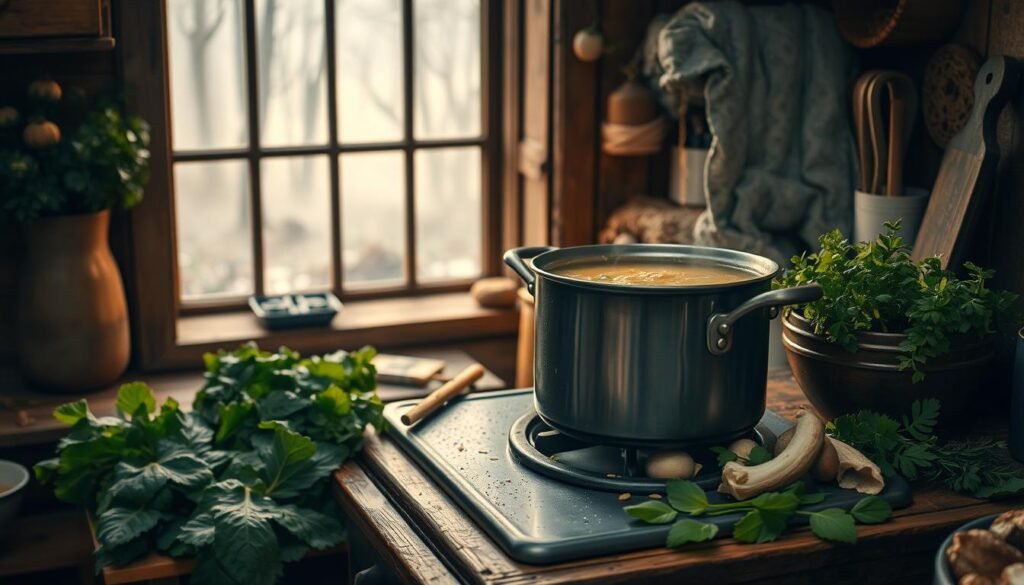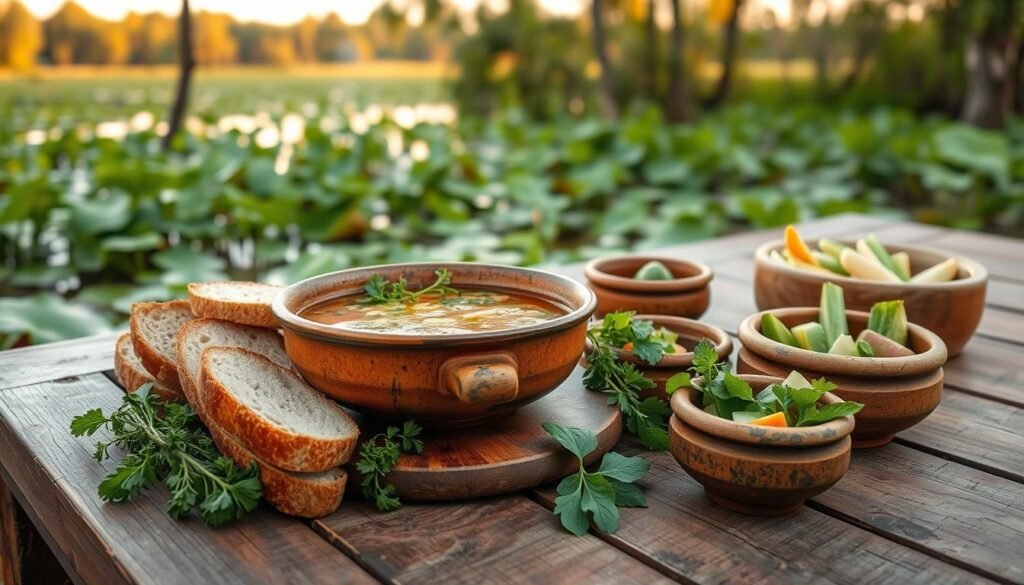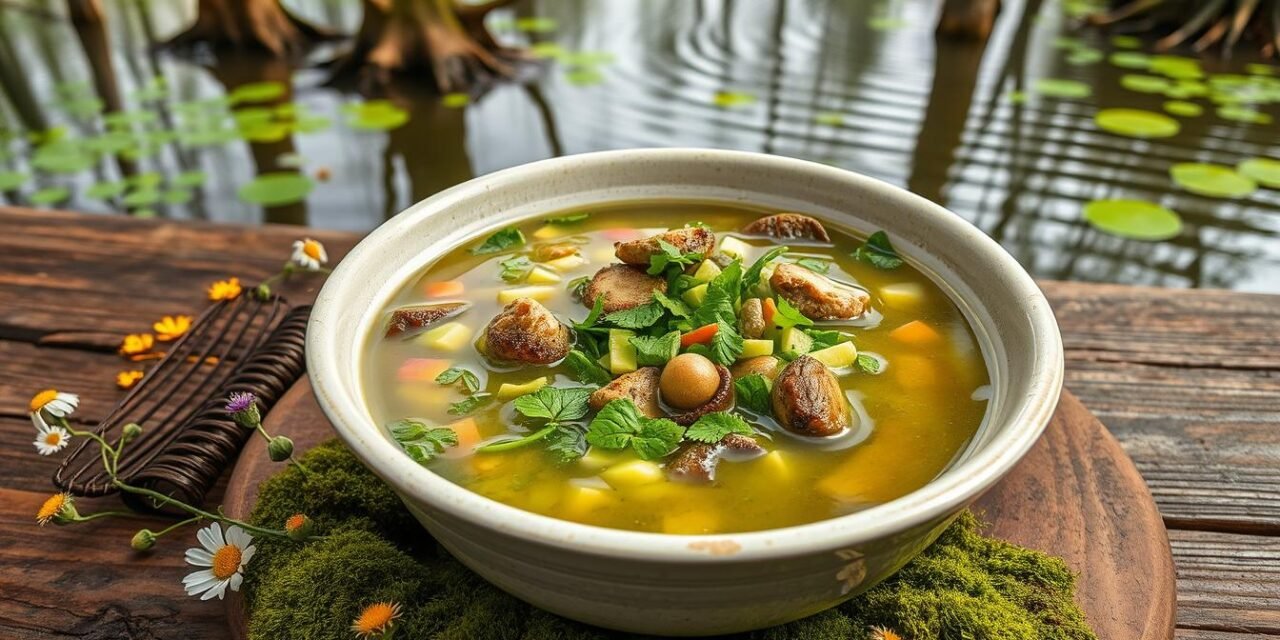I’ve explored the American South’s rich culinary traditions. My trip to Louisiana’s bayous introduced me to Cajun and Creole cuisine. Swamp Soup, in particular, has become my favorite. It shows the region’s resilience and love for the land’s bounty.
Swamp Soup looks like the bayou’s ecosystems. It’s a mix of light broth and floating greens. This dish is popular in southern Alabama, especially at Fish River Grill.
Learning about Swamp Soup, I found the right ingredients are key. Conecuh sausage is essential. The flavors blend in a way that’s both comforting and exciting.
Key Takeaways
- Swamp Soup is a beloved Cajun and Creole dish that originates from the Louisiana bayou region.
- The dish is characterized by its light mud-colored broth and floating clumps of greens, resembling the plant matter found in a stagnant wetland.
- Conecuh sausage is the essential ingredient that provides the protein base for the soup, unlike Turnip Green Soup which uses bacon.
- Swamp Soup has gained popularity in southern Alabama, particularly at the Fish River Grill, which features it as a signature dish year-round.
- The recipe can be customized with various proteins and vegetables, making it a versatile and comforting southern comfort food.
The Origins of Swamp Soup
Swamp soup is a unique dish loved by many. It comes from the rich Southern cuisine traditions. Its exact origins are a mystery, but it’s a favorite in Alabama’s coastal areas.
The Fish River Grill in southern Alabama has made swamp soup famous. They call themselves a “funky, junky, redneck joint.” Swamp soup is on their menu all year, showing its lasting appeal.
Table of Contents
A Beloved Southern Tradition
Swamp soup’s flavor and look come from Cajun and Creole cooking. Its green color, from spinach and jalapeño, makes it stand out. It’s unlike other soups.
The viral recipe has won many hearts. Swamp soup’s origins are a key part of Southern food history. It shows the South’s love for its food traditions.
| Dish | Region | Similarities to Swamp Soup |
|---|---|---|
| Peruvian Aguadito | Peru | Green, herb-based soup |
| Middle Eastern Mulukhiyah | Middle East | Leafy green vegetable-based soup |
| Mexican Pozole Verde | Mexico | Green, hominy-based soup |
| Asian Green Congee | Asia | Green, rice-based porridge |
“The Fish River Grill has helped popularize swamp soup in the region, featuring it as a year-round menu item and highlighting it as a ‘funky, junky, redneck joint’ specialty.”
What is Swamp Soup?
Swamp soup is a hearty dish from the American South. It has a light mud-colored broth. This broth is filled with sausage, white beans, greens, and fresh veggies.
Exploring the Flavors and Ingredients
The flavors of swamp soup come from Cajun and Creole traditions. The sausage adds smoky and spicy flavors. White beans make it creamy and sweet.
Greens add bitterness and nutrients. All these ingredients mix to create a Southern flavor that’s delicious.
| Ingredient | Quantity |
|---|---|
| Conecuh Sausage | 3 big packages, sliced into small rounds |
| White Beans | 2 cans, drained |
| Turnip or Collard Greens | 2 cans with broth |
| Vegetable Bouillon Cubes | 2 |
| Chicken Broth | 1 quart |
The mix of sausage, beans, and greens is comforting. It makes swamp soup a favorite in Southern comfort food and Cajun/Creole cuisine.
“Swamp soup is a true taste of the South, a hearty and flavorful dish that captures the essence of the region’s culinary heritage.”
Ingredient Selection and Quality
I’ve spent years learning about Southern cooking. I know how important it is to pick the best ingredients for swamp soup. The quality of your produce, meats, and spices makes all the difference.
Selecting the Freshest Produce
Choose bright, crisp turnip or collard greens for your swamp soup. These greens are key, adding nutrients and a unique flavor. Look for them at local farmers’ markets or specialty stores.
Conecuh sausage is a must for a Southern touch. But if you can’t find it, andouille sausage or smoked ham work well too.
Make sure to add freshly shelled butter beans or kidney beans to your soup. They bring a creamy texture and sweetness. If these are hard to find, canned white beans or black-eyed peas are good substitutes.
| Ingredient | Substitutes |
|---|---|
| Turnip or Collard Greens | Kale, Mustard Greens, Spinach |
| Conecuh Sausage | Andouille Sausage, Smoked Ham |
| Butter Beans | Canned White Beans, Black-eyed Peas |
By picking the best ingredients, you’ll make a swamp soup that’s true to Cajun and Creole cooking. It will also show the spirit of the American South.
The swamp soup recipe: A Step-by-Step Guide
Making the perfect swamp soup is like an art. It mixes the rich tastes of Cajun and Southern cooking. As a chef, I’m happy to share how to make this southern comfort food recipe. Let’s explore the tasty world of swamp soup!
First, get your key ingredients: Conecuh sausage, white beans, turnip or collard greens, and veggies like onions, celery, and garlic. The secret to great swamp soup is using the right cooking method and fresh ingredients.
- Begin by browning the Conecuh sausage in a big pot or Dutch oven over medium-high heat. Break it up into small pieces as it cooks.
- After the sausage browns, add the onions, celery, and garlic. Cook until they’re soft and smell good.
- Then, mix in the white beans, greens, and spices like Cajun spice, thyme, and smoked paprika.
- Put enough vegetable or chicken broth in to cover everything. Bring the soup to a gentle simmer.
- Let it simmer for 30-45 minutes. Stir now and then until the flavors mix well and the greens are soft.
Finally, taste and adjust the seasoning. Add salt, pepper, or Cajun spice as needed. Serve hot, topped with parsley or scallions, for a cozy southern comfort food recipe.

Swamp soup is great because you can change it up. Try different sausages, beans, or greens to make it your own. With this guide, you’ll make a cajun stew preparation that will warm your heart and please your taste buds.
Customizing Your Swamp Soup
Swamp soup is very versatile. As a chef, I’ve tried many versions in the South. You can change the protein or greens to make it your own.
Variations and Substitutions
Swamp soup can have many ingredients. Try andouille, chorizo, or plant-based sausages instead of smoked sausage for a veggie option. You can also use kale, mustard greens, or mix different greens.
To add more texture and protein, use beans like kidney, black, or cannellini. They make the soup heartier and healthier.
For a creamier soup, add heavy cream or coconut milk at the end. This makes the soup richer and more indulgent.
Remember, the best swamp soup comes from using fresh ingredients. Don’t be afraid to try new flavors that fit the Southern taste.
Serving and Pairing Suggestions
Serving swamp soup is an art that makes meals special. It goes well with many Southern sides, making meals balanced and satisfying.
Cornbread is a classic with swamp soup. Its sweet, crumbly taste matches the soup’s rich flavors. For a twist, try a green salad with tangy dressing. It cuts the soup’s heaviness.
Coleslaw or potato salad also pair well. Their cool, creamy texture contrasts with the soup’s warmth. This makes for a great Southern meal.
- Cornbread: The classic pairing that soaks up the flavorful broth
- Green Salad: A refreshing contrast to the richness of the soup
- Coleslaw or Potato Salad: Cool, creamy sides that balance the warmth of the soup
For drinks, sweet tea or a craft beer with citrus is perfect. They match the soup’s bold flavors and quench your thirst.

Swamp soup is versatile. You can pair it with traditional or modern sides. The goal is to highlight the soup’s flavors with the right dishes and drinks.
The Cultural Significance of Swamp Soup
As a seasoned chef, I’ve seen the world. Swamp soup in the American South is special. It’s not just food; it’s a tradition that links people to their roots and the rich Cajun and Creole heritage.
Swamp soup comes from the Gulf Coast. Its green colors and tender greens show the region’s wetlands and natural wealth.
The soup’s taste is a mix of smoky sausage, seafood, and veggies. It’s a taste of the Gulf Coast. Every bite takes you to the bayou’s heart.
For Southerners, swamp soup is comfort food. It feeds the body and soul. Sharing it reminds us of community and shared experiences.
Thinking about swamp soup, I see its big impact on the South. It’s not just tasty; it keeps the South’s food heritage alive. It connects people to their history and flavors.
“Swamp soup is more than just a dish; it is a testament to the resilience and ingenuity of the Southern people, a reflection of their deep connection to the land and the sea that have sustained them for generations.”
Swamp Soup vs. Turnip Green Soup
I’ve explored the American South’s diverse food traditions. From Louisiana’s swamps to Tennessee’s hills, I’ve found a big difference between swamp soup and turnip green soup.
Swamp soup is a hearty dish with sausage as the main ingredient. It has a rich broth with a smoky taste from andouille or Cajun sausage. Turnip green soup, on the other hand, uses turnip greens for a unique flavor.
| Swamp Soup | Turnip Green Soup |
|---|---|
| Main Protein: Sausage (often Andouille or Cajun-style) | Main Protein: Bacon |
| Broth: Rich and savory, with a smoky undertone | Broth: Earthy and slightly bitter, often enhanced with ham or smoked meats |
| Typical Ingredients: Sausage, onions, bell peppers, tomatoes, okra | Typical Ingredients: Turnip greens, potatoes, onions, garlic, bacon |
| Cultural Associations: Cajun and Creole cuisine | Cultural Associations: Broader Southern stew traditions |
Swamp soup and turnip green soup are both loved in the South. But they show different regional flavors and traditions. Swamp soup is linked to Louisiana’s Cajun and Creole cooking. Turnip green soup is part of the wider Southern stew tradition.
These soups are not just different in taste and ingredients. They also show the rich variety of Southern food. It’s been a joy to explore these differences and share them with others who love food.
Vegetarian and Vegan Swamp Soup Options
Looking for a meat-free version of vegetarian swamp soup? There are many tasty options. The trick is to pick the right plant-based proteins and adjust the broth and ingredients. This way, you get a delicious and filling vegan swamp soup.
Try using meat-free protein substitutes like Quorn grounds or seasoned tempeh strips. They mimic the texture and taste of sausage. Plus, they add protein to your meal.
To make a tasty broth for vegetarian swamp soup, use veggies, herbs, and spices. Mushrooms, onions, garlic, and other aromatics simmered together create a rich flavor. Adding soy sauce or tamari at the end boosts the taste even more.
| Vegetarian Swamp Soup | Vegan Swamp Soup |
|---|---|
|
|
With a few easy changes, you can make a tasty vegetarian swamp soup or vegan swamp soup. Focus on using plant-based ingredients. This way, you get a hearty, flavorful meal that suits many diets.
Health Benefits of Swamp Soup
Swamp soup is more than just tasty. It’s also very good for you. It’s full of nutrients that help keep you healthy.
Nutritional Value of Swamp Soup
Swamp soup has 140 calories, 18 grams of carbs, 8 grams of protein, and 6 grams of fat. It’s rich in vitamins A, C, Calcium, and Iron. It also has lots of potassium and fiber, making it very filling.
Dietary Modifications for Swamp Soup
- Gluten-free: Use gluten-free broth instead of regular. Make sure all thickening agents and garnishes are gluten-free too.
- Low-sodium: Use low-sodium broth and less salt. Cut down on salty ingredients like sausage and bacon.
- Vegetarian/Vegan: Use vegetable broth instead of chicken. Add extra veggies, beans, or tofu for texture.
These changes let you enjoy swamp soup while meeting different dietary needs.
| Nutrient | Amount per Serving |
|---|---|
| Calories | 140 kcal |
| Carbohydrates | 18 g |
| Protein | 8 g |
| Fat | 6 g |
| Sodium | 1376 mg |
| Potassium | 790 mg |
| Fiber | 6 g |
| Sugar | 5 g |
| Vitamin A | 1247 IU |
| Vitamin C | 182 mg |
| Calcium | 119 mg |
| Iron | 2 mg |

Swamp soup is not just tasty. It’s also packed with nutrients. It’s great for anyone looking for a healthy, delicious meal.
Tips for Making the Perfect Swamp Soup
I’ve explored many Southern cuisines as a chef. I’ve found ways to make swamp soup stand out. These tips will help you make a swamp soup that everyone will love.
Achieving the Right Balance of Flavors
The secret to great swamp soup is balancing flavors. Start by caramelizing the sausage for a smoky taste. Then, add garlic, pepper, and spices to match your dish’s flavor.
Enhancing the Texture of the Broth
For a smooth broth, simmer the soup slowly. Puree some beans or greens and mix them back in. This makes the soup creamy without cream or roux.
Perfecting the Cooking Method
Simmering on the stovetop works, but slow cookers or Instant Pots are better. They heat evenly, blending flavors perfectly. Adjust cooking times and liquids as needed.
With these tips, your swamp soup will impress everyone. Enjoy!
| Statistic | Value |
|---|---|
| Recipe Rating | 4.5 out of 5 stars (46 votes) |
| Total Servings | 12 |
| Prep Time | 10 minutes |
| Cooking Time | 1 hour and 30 minutes |
| Total Time | 1 hour and 40 minutes |
| Nutrition (per serving) |
|
“The secret to a truly exceptional swamp soup lies in the perfect balance of savory, earthy, and smoky flavors. With a few insider techniques, you can elevate this beloved Southern dish to new heights.”
Regional Variations
As I explored the American South’s food scene, I fell in love with swamp soup’s regional flavors. This dish shows the area’s rich culture, with each place adding its own twist.
In Louisiana, Cajun and Creole tastes shine through. The soup gets bold flavors from andouille sausage and Creole seasoning. A hint of spice comes from hot sauce or Cajun chili peppers. Okra makes the broth creamy and adds its own taste.
Going east, Alabama’s swamp soup is earthier. It’s made with smoked ham hocks for a deep flavor. Turnip greens, collard greens, and pork neckbones add to its hearty feel.
Every swamp soup I tried showed a common theme: celebrating fresh, local ingredients. From Louisiana’s Cajun version to Alabama’s smoky soup, each one honors its region’s unique taste.

“The true magic of swamp soup lies in its ability to transcend borders and bring people together, celebrating the shared culinary heritage of the American South.”
Storage and Reheating Tips
Enjoying swamp soup doesn’t have to stop after dinner. You can still enjoy it as leftovers with the right storage and reheating. Let’s look at how to keep your swamp soup tasty and fresh.
Storing Swamp Soup for Later
To keep your swamp soup fresh, store it right. Cool it down first, then put it in an airtight container. Store it in the fridge for up to 4 days. Or, freeze it for up to 3 months. Make sure to leave some space in the container for it to expand when it freezes.
Reheating Swamp Soup
Reheating your swamp soup gently is key. Warm it on the stovetop over low heat, stirring now and then. This keeps the flavors and texture just right. Don’t let it boil too fast, as it can ruin the soup. You can also use the microwave, but heat it in short bursts and stir between each one.
By following these tips, you can enjoy swamp soup again and again. Every bite will be as good as the first.
Conclusion
The Swamp Soup recipe is a true culinary masterpiece. It celebrates the rich flavors of Southern, Cajun, and Creole cuisines. This hearty dish has won the hearts of food lovers around the world.
Its unique taste comes from different cultures, like Mexican Pozole Verde and Middle Eastern Mulukhiyah. The recipe can be made in many ways, including vegetarian and vegan options. This makes it a dish for everyone to enjoy.
As a beloved Southern comfort food, Swamp Soup nourishes both body and soul. It connects us to the region’s culinary traditions. Whether with crusty bread, cornbread, or rice, it offers a memorable dining experience.










